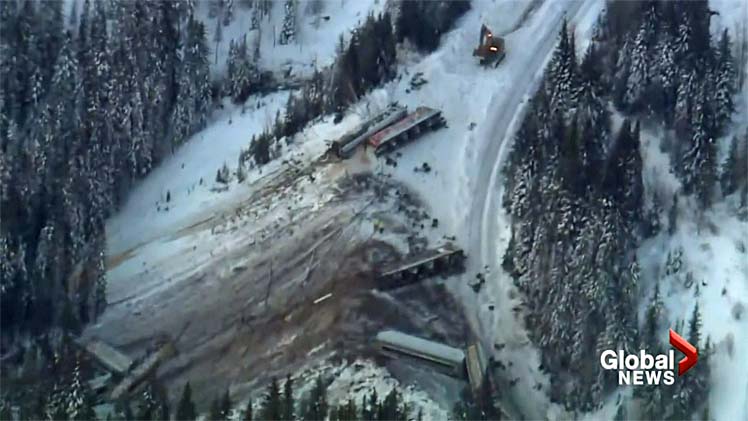
in Wake of Runaway Train Crash
Calgary Alberta - Canadian Pacific Railway (CP) has changed its operating rules for trains that make emergency stops on mountain routes and
will now require the use of hand brakes, a safety measure that follows Monday's runaway train derailment that killed three crew members.
The crew brought the 112 car grain train to an emergency stop descending a mountain route east of Field, B.C., because it had exceeded the 15 mile-an-hour
speed limit by 5 miles an hour, according to a railway industry source.
The halt is required under the company's operating rules.
The train, number 301, then sat for two hours in frigid temperatures on the main track before suddenly beginning to roll away uncontrolled with a relief crew
in the cab.
The train quickly exceeded the speed limit on the treacherous route and derailed at a bridge, plunging 200 feet into the Kicking Horse River.
The crew told dispatchers they were unable to slow the train as it hurtled down the track, among the steepest in North America.
The wreck killed conductor Dylan Paradis, engineer Andrew Dockrell, and trainee Daniel Waldenberger-Bulmer.
All three had been at the CP bunkhouse at Field when they were called to relieve crew members, who had worked their maximum permitted hours.
The Transportation Safety Board (TSB), which is investigating the cause of the derailment, said on Tuesday that no hand brakes were applied to the grain cars
while it was stopped.
The crew had made adjustments to the air brakes on three quarters of the cars, setting the retaining valves to apply them partly, a step taken in emergency
stops that is part of CP's operating rules.
The new hand brake requirement CP issued in a system-wide bulletin dated 6 Feb 2019, and obtained by The Globe and Mail, updates the procedures train crews
must perform after making an emergency stop on a mountain.
After the first emergency stop, crew members are required to apply hand brakes on 25 cars and set the air-brake retaining valves on all cars while the air
brake system is recharged.
Crew members must contact a trainmaster and undergo a "job briefing" in which they must show an understanding of the brake retainer, and provide
information on weather and other conditions that affect braking performance.
Hand brakes and retaining clips must be set on all cars in the case of a second emergency brake application.
Another industry source described the changes as significant.
Both sources were granted anonymity by The Globe because they were not authorized to speak publicly on the matter.
Under the previous rules, the use of brake retainer clips was required, but not hand brakes.
According to CP's operating rules dated 2006, and also obtained by The Globe, "weather and poor braking conditions" dictated if hand brakes were to
be set on every car.
CP's doomed train 301 began its journey in Red Deer, Alberta, and was headed to Vancouver with 112 carloads of grain and three locomotives, one at the head,
the middle, and rear.
Many of the grain cars were at least 30-years-old.
The train's configuration is known as distributed power, which improves traction and improves the effectiveness of a train's air brakes, which are pressurized
from a locomotive's generator.
OKthePK Joint Bar Editor: Pressurized from a locomotive's air compressor.
The train had no mechanical problems and had recently passed a brake test at CP's Calgary yard, said the first industry source.
The crew members were based in Calgary, and were waiting at the station in Field for their next shift, which would take them home.
Instead, they were called to relieve the crew on train 301 a short distance up the mountain, "If everything would have worked out, they would have gone
up, grabbed that train, taken it into Field, and handed it off to another crew headed west to Vancouver, and then gone back into the bunkhouse," the
source said.
"It was the luck of the draw."
CP, based in Calgary, declined to comment Thursday, beyond referring questions to the TSB and saying it is co-operating with the investigation.
The TSB declined to comment.
A train is equipped with overlapping brake systems, the dynamic, back pressure brakes of the locomotive's power, the locomotive's independent brakes, and the
air brake system that encompasses every car, fed compressed air by the locomotive.
Hand brakes, used when cars are stopped, require a crew member to manually turn a hand wheel on each car to apply and set the pads against the
wheels.
This is a physically demanding task, especially when done on dozens of cars in cold weather.
Trains used to employ brakemen for the task now added to the responsibilities of a conductor.
Not enough hand brakes were set on the oil train that rolled into Lake Megantic killing 47 people in 2013, investigators found.
The train's air brakes had lost pressure after sitting for several hours before it rolled downhill and exploded, destroying much of the town.
The TSB investigation into the wreck of train 301 will include the role air brakes played in the uncontrolled plunge down the tracks.
A train's air brakes become less effective in sub-zero temperatures and snowy conditions.
The gaskets, seals, and hoses shrink, become brittle and leak air, a problem that can be compounded by the equipment's age.
Almost half of Canada's 23,000 grain cars are owned by the federal or provincial government and operated under agreements with the railways.
The rest are owned by the rail companies and G3 Canada Ltd., the former Canadian Wheat Board.
Eric Atkins.
provisions in Section 29 of the Canadian
Copyright Modernization Act.

